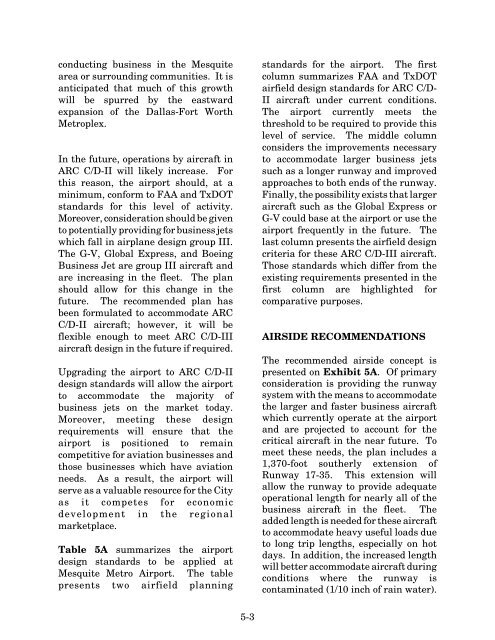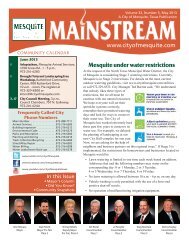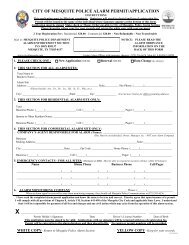airport/documents/Mesquite Master Plan Final.pdf - The City of ...
airport/documents/Mesquite Master Plan Final.pdf - The City of ...
airport/documents/Mesquite Master Plan Final.pdf - The City of ...
You also want an ePaper? Increase the reach of your titles
YUMPU automatically turns print PDFs into web optimized ePapers that Google loves.
conducting business in the <strong>Mesquite</strong><br />
area or surrounding communities. It is<br />
anticipated that much <strong>of</strong> this growth<br />
will be spurred by the eastward<br />
expansion <strong>of</strong> the Dallas-Fort Worth<br />
Metroplex.<br />
In the future, operations by aircraft in<br />
ARC C/D-II will likely increase. For<br />
this reason, the <strong>airport</strong> should, at a<br />
minimum, conform to FAA and TxDOT<br />
standards for this level <strong>of</strong> activity.<br />
Moreover, consideration should be given<br />
to potentially providing for business jets<br />
which fall in airplane design group III.<br />
<strong>The</strong> G-V, Global Express, and Boeing<br />
Business Jet are group III aircraft and<br />
are increasing in the fleet. <strong>The</strong> plan<br />
should allow for this change in the<br />
future. <strong>The</strong> recommended plan has<br />
been formulated to accommodate ARC<br />
C/D-II aircraft; however, it will be<br />
flexible enough to meet ARC C/D-III<br />
aircraft design in the future if required.<br />
Upgrading the <strong>airport</strong> to ARC C/D-II<br />
design standards will allow the <strong>airport</strong><br />
to accommodate the majority <strong>of</strong><br />
business jets on the market today.<br />
Moreover, meeting these design<br />
requirements will ensure that the<br />
<strong>airport</strong> is positioned to remain<br />
competitive for aviation businesses and<br />
those businesses which have aviation<br />
needs. As a result, the <strong>airport</strong> will<br />
serve as a valuable resource for the <strong>City</strong><br />
as it competes for economic<br />
development in the regional<br />
marketplace.<br />
Table 5A summarizes the <strong>airport</strong><br />
design standards to be applied at<br />
<strong>Mesquite</strong> Metro Airport. <strong>The</strong> table<br />
presents two airfield planning<br />
5-3<br />
standards for the <strong>airport</strong>. <strong>The</strong> first<br />
column summarizes FAA and TxDOT<br />
airfield design standards for ARC C/D-<br />
II aircraft under current conditions.<br />
<strong>The</strong> <strong>airport</strong> currently meets the<br />
threshold to be required to provide this<br />
level <strong>of</strong> service. <strong>The</strong> middle column<br />
considers the improvements necessary<br />
to accommodate larger business jets<br />
such as a longer runway and improved<br />
approaches to both ends <strong>of</strong> the runway.<br />
<strong>Final</strong>ly, the possibility exists that larger<br />
aircraft such as the Global Express or<br />
G-V could base at the <strong>airport</strong> or use the<br />
<strong>airport</strong> frequently in the future. <strong>The</strong><br />
last column presents the airfield design<br />
criteria for these ARC C/D-III aircraft.<br />
Those standards which differ from the<br />
existing requirements presented in the<br />
first column are highlighted for<br />
comparative purposes.<br />
AIRSIDE RECOMMENDATIONS<br />
<strong>The</strong> recommended airside concept is<br />
presented on Exhibit 5A. Of primary<br />
consideration is providing the runway<br />
system with the means to accommodate<br />
the larger and faster business aircraft<br />
which currently operate at the <strong>airport</strong><br />
and are projected to account for the<br />
critical aircraft in the near future. To<br />
meet these needs, the plan includes a<br />
1,370-foot southerly extension <strong>of</strong><br />
Runway 17-35. This extension will<br />
allow the runway to provide adequate<br />
operational length for nearly all <strong>of</strong> the<br />
business aircraft in the fleet. <strong>The</strong><br />
added length is needed for these aircraft<br />
to accommodate heavy useful loads due<br />
to long trip lengths, especially on hot<br />
days. In addition, the increased length<br />
will better accommodate aircraft during<br />
conditions where the runway is<br />
contaminated (1/10 inch <strong>of</strong> rain water).




